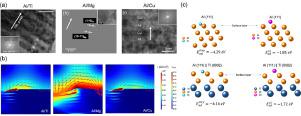Acta Materialia ( IF 8.3 ) Pub Date : 2021-01-04 , DOI: 10.1016/j.actamat.2020.116609 Wenbo Wang , Kaiwen Wang , Zhengyu Zhang , Jia Chen , Tianyou Mou , F. Marc Michel , Hongliang Xin , Wenjun Cai

|
Tribocorrosion damage on metal surfaces imposes a great challenge to their reliable long-term performance in corrosive environment. In the present work, we showed that nanostructured metallic multilayers (NMMs) exhibited ultrahigh tribocorrosion resistance owing to abundant interfaces and nanoscale chemical modulation that effectively restricted plastic deformation, reduced micro-galvanic corrosion and surface reactivity. Specifically, the tribocorrosion behaviors of equal-spaced Al/X (X = Ti, Mg and Cu) NMMs with ~ 3 nm individual layer thickness were studied in 0.6 M NaCl aqueous solution under room temperature. Nanomechanical and electrochemical measurements were coupled with advanced material characterization tools to study the effects of constituting materials on the deformation and degradation mechanisms. It was found that while corrosion dominated in Al/Mg and Al/Cu NMMs, severe plastic deformation dominated in Al/Ti during tribocorrosion due to sustained surface passivity. A finite element (FE) based computational model was developed and validated to quantify the tribocorrosion behavior of all NMMs, which showed accelerated material loss at layer interfaces as well as wear track edge resulting from the synergistic effects of wear and corrosion. Finally, density functional theory (DFT) calculations were carried out to uncover the origin of corrosion resistance in NMM. It was found that via nanolayering, the surface work function of Al was increased while Cl adatoms adsorb less strongly than that on pure Al, thus reducing the surface reactivity and pitting susceptibility. The combined experimental and computational study provides a guideline for future material selection and design of multilayered and multi-phase metals for use under extreme environment.
中文翻译:

纳米层使金属具有超高的抗摩擦腐蚀性能
金属表面的摩擦腐蚀损坏对其在腐蚀环境中的可靠长期性能提出了巨大挑战。在目前的工作中,我们显示出纳米结构的金属多层(NMM)由于具有丰富的界面和纳米级化学调制而表现出超高的耐摩擦腐蚀性能,有效地限制了塑性变形,降低了微电腐蚀和表面反应性。具体而言,在室温下于0.6 M NaCl水溶液中研究了具有约3 nm单层厚度的等距Al / X(X = Ti,Mg和Cu)NMM的摩擦腐蚀行为。纳米力学和电化学测量与先进的材料表征工具相结合,以研究构成材料对变形和降解机理的影响。结果发现,尽管在Al / Mg和Al / Cu NMMs中腐蚀占主导地位,但由于持续的表面钝化,在摩擦期间Al / Ti中严重的塑性变形占主导。开发并验证了基于有限元(FE)的计算模型,以量化所有NMM的摩擦腐蚀行为,这显示出层界面处的加速材料损失以及磨损和腐蚀的协同效应导致的磨损痕迹边缘。最后,进行密度泛函理论(DFT)计算以揭示NMM中耐腐蚀的起源。发现通过纳米层,Al的表面功函数增加,而Cl吸附原子的吸附作用不如纯Al强,从而降低了表面反应性和点蚀敏感性。










































 京公网安备 11010802027423号
京公网安备 11010802027423号